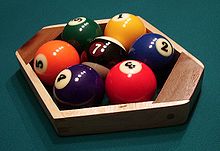Seven-ball

Seven-ball is a rotation pool game with rules similar to nine-ball, though it differs in two key ways: the game uses only seven object balls as implied by its name, and play is restricted to particular pockets of the table. William D. Clayton is credited with the game's invention in the early 1980s.[1]
Rules[]
At the start of the game, balls one through seven are racked in a hexagonal configuration, with the 1-ball placed at the rack's apex, centered over the table's foot spot, the 7-ball placed at the rack's center, and all other balls placed clockwise (see photo top right). Immediately following the break shot, the opponent must elect three pockets along one of the table's long rails, and the player who broke is automatically assigned the three pockets situated along the opposite long rail. Once that selection is made, balls 1–6 may be pocketed in any pocket in rotation, starting with the one, as the object ball. Balls pocketed via combinations off of the object ball are legal. The 7-ball must be pocketed in the called side to be a legal win. Scratches on any object ball allow the opponent ball-in-hand, but the sunk ball remains potted. Scratching on the 7-ball is a loss. Pocketing the 7-ball in any other pocket than the called side is a loss.[2]
A special 7-ball was designed for television matches by Charles Ursitti (billiards historian, referee and Willie Mosconi's one time manager) to address the problem that the color of the seven and three balls in a standard set of pool balls are nearly indistinguishable when viewed on a TV screen.[1] The ball adopts the stripe of the 9-ball with the color of the solid black 8-ball, the "money balls" of their respective namesake games.[citation needed]
Equipment[]

No special equipment is required for play in pool halls or home pool rooms. As illustrated to the left, a regular set of pool balls and a nine-ball diamond rack turned sidewise are adequate.

If no nine-ball diamond rack is provided, as illustrated to the right, a standard fifteen-ball triangle rack placed diagonally with the apex pointing towards the left or the right of the headstring end table is also adequate for racking up the object balls, albeit with an unused object ball or the cueball in the apex corner, which is then gently rolled off after the triangle rack is lifted.[3][4]
Playing Seven-ball on a coin-operated Pool table[]


When Seven-ball Pool is played on a coin operated Pool table, as illustrated to the left, the game can be played with the solid coloured balls 1 to 7 for the first rack and the leftover striped balls 9 to 15 for the second rack.


Alternatively, as illustrated to the right, to make it easier to see the "Money Ball", the striped 15-Ball can be used as the 7-Ball with the solid coloured balls 1 to 6, and the solid 7-Ball can be used as the 15-Ball with the stripe coloured balls 9 to 14.
The 8-Ball is discarded, however it can be used as an apex corner ball when racking a game of Seven-ball Pool with a standard fifteen-ball triangle rack and rolled off after the triangle rack is lifted.
Rule Variants[]
The original informal incarnation of seven ball led to a variant professional ruleset that enjoyed a brief heyday in the Sudden Death Seven-ball series of pro tournaments, broadcast on the American cable TV network ESPN from 2000 to 2005.
References[]
- ^ Jump up to: a b Shamos, Michael Ian (1993). The Illustrated Encyclopedia of Billiards. New York, NY: Lyons & Burford. pp. 206. ISBN 1-55821-219-1.
- ^ Billiard Congress of America, ed. (2005). Billiards: The Official Rules and Records Book. Billiard Congress of America. pp. 59–61. ISBN 9781592287444.
- ^ 7Ball Final 2004 - Corey Deuel vs Ralf Souquet https://www.youtube.com/watch?v=ot-G_uTEjhQ&t=137s
- ^ 7Ball Bustamante vs Immonen https://www.youtube.com/watch?v=4JNZvzvA-pc&t=97s
- Pool (cue sports)
